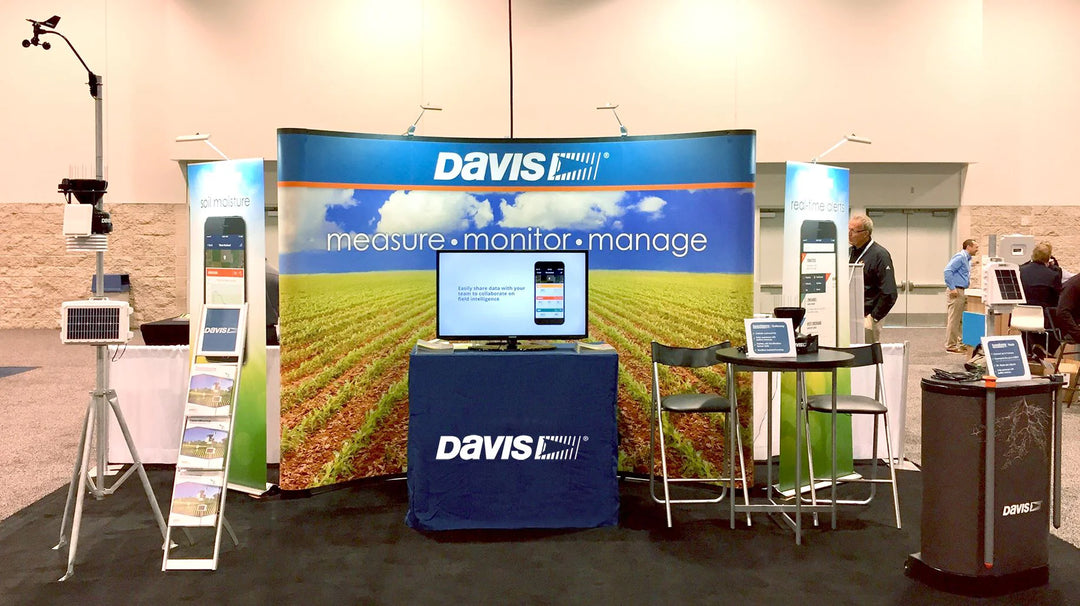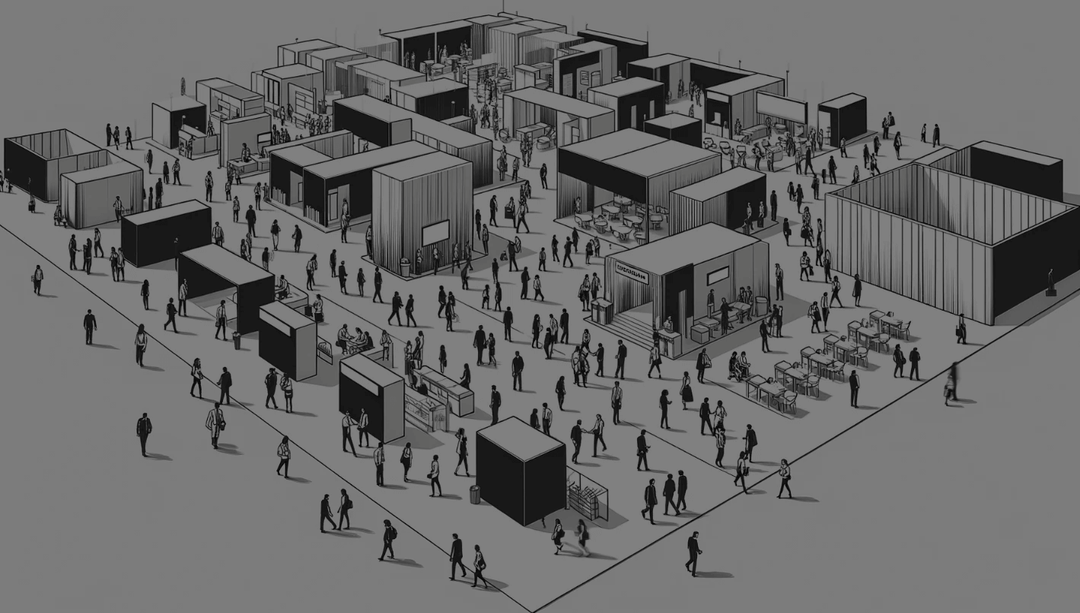Faced with the challenge of planning a successful trade show?
You’re not alone.
Many struggle with where to start and how to ensure every detail is covered. That’s why we’ve created a comprehensive guide to walk you through each stage of trade show planning.
Accompanied by a detailed checklist template in PDF format, this guide promises to equip you with all the tools needed to plan, execute, and succeed in your trade show endeavors.
Stage 1: 12 Months Before

Research and Select Trade Shows: Evaluate trade shows based on industry relevance, past attendee and exhibitor feedback, geographical location, and potential ROI. Utilize trade association data, past event reports, and industry forums to make informed decisions.
Book Your Booth: Identify and reserve the optimal booth location at the selected trade show. Consider factors like foot traffic, proximity to entrances and major exhibitors, and layout visibility. Contact the event organizers for floor plans and pricing options, and secure your spot by fulfilling any necessary deposit requirements early to avoid missing out on preferred locations.
Stage 2: 9 Months Before

Now entering a critical phase, you'll start turning concepts into concrete actions. This stage involves detailed planning for booth design, travel logistics, and initial marketing efforts, setting the stage for a successful exhibition.
Design Booth: Initiate the design process for your booth with a focus on maximizing brand visibility and engagement. Collaborate with designers to create an interactive and visually appealing environment that resonates with your target audience. Consider factors such as traffic flow within the booth, branding placement, branded displays, and space for private meetings.
Travel Arrangements: Secure travel arrangements to ensure cost-effectiveness and convenience for your team. Investigate group discounts and early booking benefits for flights and accommodations. Consider proximity to the venue when selecting hotels to minimize travel time and enhance convenience for booth staff.
Start Marketing Plan: Develop a comprehensive trade show marketing strategy tailored to different stages of the trade show. This should include pre-show awareness campaigns via email and social media, engaging activities during the show to draw attendees to your booth, and follow-up communications post-show to convert leads into customers.
Vendor Contracts: Start the process of securing necessary services by identifying and negotiating contracts with vendors such as booth constructors, logistics firms, and technology providers. Ensure contracts are clear on deliverables, costs, and timelines to avoid last-minute surprises. Compare multiple vendors to find the best match for quality, reliability, and price.
Stage 3: 6 Months Before

Six months before the event, you'll start to see your plans take shape. Focus now on ordering promotional materials, training your booth staff, and organizing the technology that will make your booth stand out.
Order Promotional Materials: Finalize designs and place orders for promotional materials that will represent your brand effectively at the show. Choose high-quality brochures, custom branded display products, eye-catching flyers, memorable giveaways, and professional business cards that reflect your company’s image and message.
Training Staff: Select and begin training the team members who will staff your booth. Focus on product knowledge, brand messaging, and customer interaction techniques. Implement role-playing exercises to enhance their skills in handling different types of visitors and situations they may encounter at the booth.
Technology Requirements: Assess and arrange for any technology needs your booth might have. This includes Wi-Fi access, electronic displays, AV equipment for presentations, and interactive touchscreens. Ensure compatibility with the event’s facilities and consider backups for critical components.
Interactive Elements: Develop and integrate interactive elements that can attract and engage attendees. These could include virtual reality experiences, interactive product demonstrations, or gamified elements that make visiting your booth a memorable experience.
Stage 4: 3 Months Before

Three months before the event, your focus should shift to final preparations. This includes confirming booth designs, scheduling important meetings, and organizing logistics to avoid last-minute hurdles.
Finalize Booth Design: Confirm the final design and layout of your booth. Ensure that it not only reflects your brand effectively but also meets all the event's specifications and space requirements. Double-check accessibility and functionality to accommodate both staff and visitors comfortably.
Schedule Meetings: Proactively set up meetings with key clients, partners, and leads who will be attending the show. Use this opportunity to strengthen relationships and finalize discussions in a face-to-face setting. Coordinate schedules and confirm meeting spaces early to ensure availability.
Logistics Planning: Organize all logistical aspects of getting your booth materials to the trade show venue. This includes arranging transportation, handling, and storage of your display materials. Confirm arrangements with shipping companies and the event’s logistics team to ensure a smooth setup and breakdown.
Contingency Planning: Prepare for any unforeseen circumstances that might affect your participation in the trade show. Develop backup plans for critical areas such as staffing, technology failures, and material delivery delays. Ensure you have contacts for emergency services and a list of alternative vendors.
Stage 5: 1 Month Before

With only a month left until the trade show, it’s crucial to ensure that all your plans are set and every detail is locked in. This stage focuses on final confirmations, ramping up your marketing efforts, and ensuring your team is ready to perform.
Confirm Details: Go through all bookings and schedules again to ensure everything is in place. Double-check travel arrangements, hotel accommodations, freight schedules, and any on-site services you have booked.
Pre-Trade Show Marketing: Intensify your marketing efforts to maximize event attendance and booth traffic. Use email blasts, social media posts, and targeted advertisements to remind potential customers of your presence at the show.
Prepare Documentation: Collect and organize all necessary paperwork required for a smooth experience. This includes insurance policies, signed contracts, permits, and any regulatory documents. Make sure everything is current and compliant with local laws and the event's rules.
Booth Staff Schedule: Finalize the staffing schedule for your booth. Assign specific roles and responsibilities to each team member, ensuring coverage throughout the event hours. Distribute the schedule and ensure everyone understands their duties and the overall flow of the event.
Stage 6: 2 Weeks Before

With the trade show just around the corner, the next two weeks will be key for final touches. It's time to ensure your staff is well-informed, your materials are ready, and your goals are clearly defined and achievable
Final Briefing: Conduct a final meeting with all staff members who will be at the trade show. Review the comprehensive trade show plan, clarify roles and responsibilities, and discuss the overall objectives. Ensure everyone is clear on their tasks and the expectations during the event.
Pack Essentials: Gather and pack all necessary materials for the booth setup, including promotional items, display solutions, and a toolkit for emergency repairs. Check that all equipment is functional and packed securely to avoid any damage during transport.
Review Goals and Objectives: Reassess the specific goals and objectives set for the trade show. Make sure all planned activities, from lead generation tactics to product demonstrations, are designed to meet these targets.
Stage 7: 1 Week Before

Entering the week before the trade show, the priority shifts to final logistics and strengthening connections. It's time to ensure your booth materials are en route and all scheduled meetings are confirmed.
Ship Materials: Verify that all booth materials, including displays, promotional items, and any other necessary equipment, are shipped according to the planned schedule. Coordinate closely with your logistics provider to track the shipping progress and confirm the arrival times at the trade show venue, ensuring everything arrives in good condition and on time.
Check-in With Contacts: Reach out to your pre-scheduled contacts, including potential clients, existing customers, and partners, to confirm their attendance and meeting times during the trade show. This ensures that your networking and sales strategies are set to go as planned and allows for any last-minute adjustments to your meeting schedule.
Stage 8: Day Before

With just a day left, now is the time to put the finishing touches on your trade show preparations. Focus on setting up your booth, fine-tuning the details, and practicing your pitches to make a strong impression from the start.
Set Up Booth: Arrive at the venue early to begin setting up your booth. Supervise the assembly and arrangement of all booth components to make sure everything aligns with your planned layout and design. Address any issues with the setup team to ensure your booth is visually appealing and functional.
Final Walk-through: Conduct a comprehensive final walk-through of your booth once setup is complete. Check for any visual inconsistencies, functionality issues with displays or technology, and overall readiness. Make any necessary tweaks to optimize the space and ensure everything is in perfect order for the visitors.
Rehearse Presentations and Pitches: Gather your team for a final rehearsal of any presentations, pitches, or product demonstrations. Focus on delivery, timing, and interaction to ensure a smooth performance. This rehearsal helps boost confidence and iron out any last-minute jitters.
Stage 9: Day of the Show

The day of the trade show is here, and it’s all about interaction and engagement. Today, your focus is on making meaningful connections, collecting valuable leads, and keeping your online audience informed and excited about what’s happening live.
Engage Attendees: Be proactive in engaging with booth visitors from the moment the doors open. Use trained staff to greet attendees, explain your products or services, and effectively communicate your brand message. Encourage interactions through live demonstrations, Q&A sessions, or hands-on experiences. Focus on collecting leads by capturing contact information and noting specific interests or needs of each visitor.
Social Media Updates: Utilize social media to amplify your presence at the trade show. Post live updates, photos, and videos throughout the day to highlight key moments and draw more attendees to your booth. Engage online followers with interactive content such as polls, live streams, or behind-the-scenes looks.
Stage 10: Post-Show

The trade show may be over, but the work continues. Now is the time to follow up diligently on leads, evaluate your overall performance, and debrief with your team.
Follow Up on Leads: Initiate follow-up with leads within the first week after the trade show. Use personalized communication tailored to each contact’s interests and your interactions at the booth. Employ various methods such as emails, phone calls, or social media messages to maintain engagement. Prioritize leads based on their potential for conversion to ensure timely and effective follow-ups.
Evaluate Performance: Conduct a thorough review of your trade show efforts against the pre-set goals and objectives. Analyze metrics such as lead generation numbers, the quality of engagements, sales conversions, and overall ROI. Use this data to determine what strategies were successful and what areas need improvement.
Team Debrief: Schedule a debrief session with your entire team to discuss the trade show. Encourage open dialogue about what aspects went well and what could be improved. Collect insights from different team members, including those involved in logistics, booth management, and customer engagement. Use this feedback to refine strategies and planning for future trade shows.
From Planning to Performance at Your Trade Show
Now that you've walked through a year of trade show planning, from the initial anticipation to the reflective post-show analysis, it's time to put this knowledge into practice. Download the trade show planning checklist, tailor it to your specific needs, and step into your next trade show with confidence.
Remember, as Amelia Earhart famously said, 'The most difficult thing is the decision to act, the rest is merely tenacity.'
Every great achievement begins with the decision to try. With this strategic timeline and checklist in hand, you are well-equipped to face the challenges of a trade show and transform them into your success stories.



